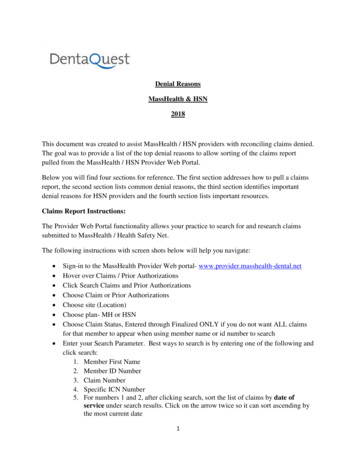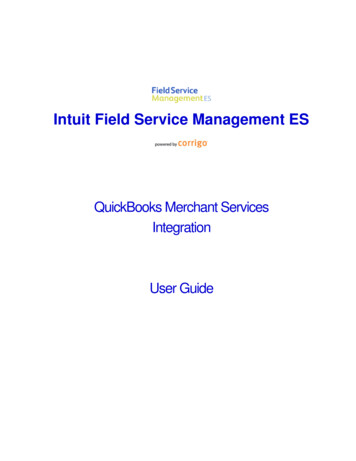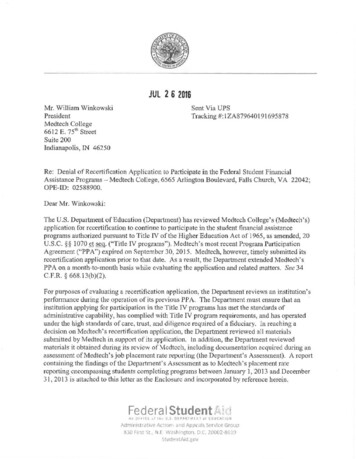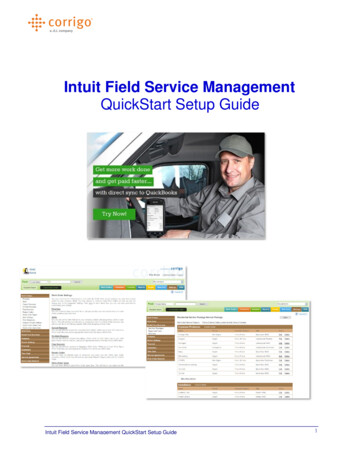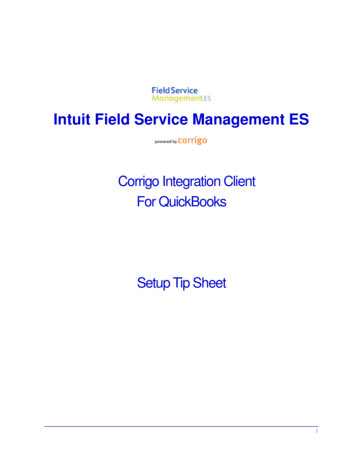
Transcription
Denial management:Field-tested techniques that get claims paidBy Elizabeth W. Woodcock, MBA, FACMPE, CPCObjectivesFailing to adequately work denials from insurers translates to lost revenue for your medicalpractice. Presenting the four steps to effective denial management — Identify, Manage,Monitor and Prevent — this white paper provides the reader with knowledge to: Recognize opportunities to identify and correct the issues that cause claims to bedenied by insurers. Classify denials by reason, source, cause and other distinguishing factors. Develop and assess effective denial management strategies. Implement strategies that engage patients, referring physicians and others to effectivelyappeal and reverse unfounded denials.Readers will discover field-tested techniques and best practice tools and resources to helptheir practice effectively manage its denials — and ensure a healthy bottom line.optum.comMedical practices that lack a focusedstrategy for denial management aremore apt to see denials resolvedunfavorably or, as is all too common,left to languish and eventuallywritten off as bad debt.
Denial management: Field-tested techniques that get claims paidIdentify, Manage, Monitor, PreventPhysicians transmit millions of claims to insurers every day. Most claims are adjudicatedpromptly and for the full contracted amount, but a notable minority is returned unpaid.Indeed, the American Medical Association reports that between 1.38 percent and5.07 percent of claims are denied by insurers on the first submission. (See Figure 1.)Even the best-performing medical practices experience a denial rate of 5 percent, revealsthe Medical Group Management Association in its 2012 Performance and Practices ofSuccessful Medical Groups report.The first step in a successful claimsresolution approach is to identify notonly that a claim has been denied,but also the reason for the denial.Denied claims represent unpaid services — and lost or delayed revenue to your practice.Importantly, they also signify an avoidable cost to the medical practice. Employees’ timespent managing and — ideally — resolving denials saps significant resources from themedical practice’s business office. Medical practices that lack a focused strategyfor denial management are more apt to see denials unfavorably resolved or, as is alltoo common, left to languish and eventually be written off as bad debt. ConsiderFigure 1 — claim denials are highly variable by insurer, necessitating a carefullyconstructed process to optimize revenue for a medical practice.Figure 1: Denied claims by %3.78%Source: 2012 National Health Insurer Report Card, American Medical Association. Question: “What percentage ofclaim lines submitted are denied by the payer for reasons other than a claim edit?” According to the survey, a denialis defined as the allowed amount equal to the billed charge and the payment equals 0.While it’s easy to throw up your hands in frustration, it is business-critical to develop andoptimize proven techniques that get claims paid. This white paper serves to outline fieldtested techniques that get claims paid by using the four-step IMMP process — Identify,Manage, Monitor and Prevent.optum.comPage 2
Denial management: Field-tested techniques that get claims paidStep 1: IdentifyThe first step in a successful claims resolution approach is to identify not only that aclaim has been denied, but also the reason for the denial. When adjudicated claims arereturned unpaid, the insurer will indicate the reason on the accompanying explanationof payment. These indicators, known as claims adjustment reason codes (CARC), areapplied at the line item — CPT code — level. Each CARC may be further explained in anaccompanying remittance advice remark code (RARC). Figure 2 outlines a sample of claimadjustment reason codes utilized by insurers.Figure 2: Sample claim adjustment reason codes4The procedure code is inconsistent with the modifier used or a requiredmodifier is missing.22This care may be covered by another payer per coordination of benefits.38Services not provided or authorized by designated(network/primary care) providers.55Procedure/treatment is deemed experimental/investigational by the payer.97The benefit for this service is included in the payment/allowance for anotherservice/procedure that has already been adjudicated.“While unpleasant to receive,claim denials — particularly theinformation about the type, numberand source of the denial — areinvaluable business intelligence for amedical practice.”Source: Washington Publishing Company, 2013. Accessed http://www.wpc-edi.com/content/view/695/1on June 9, 2013.It sounds simple: Just review the code and determine why the insurer denied the claim.But is it really that easy?Unfortunately, deciphering and interpreting this feedback from the insurer is anythingbut elementary. First, the codes are typically in alpha-numeric form, so your employeesmust map the insurer’s code to the description of the reason. Additionally, manycodes are cryptic. For example, CARC 16 is: “Claim/service lacks information which isneeded for adjudication.” What information is lacking? It requires digging for answers:the remittances from many insurers will not provide sufficient detail to answer thatquestion, leaving it up to the employees of the practice’s business office to effectivelyexecute laborious research at times to discover what — if any — additional criticalinformation is needed.The CARC numbers also are frequently accompanied by a two-letter alpha code.These codes, which typically precede the reason and remark codes, indicate whichparty the insurer feels is responsible to pay the denied amount. The codes of this typeinclude “PR” to indicate patient responsibility and “CO” to indicate contractualobligation — meaning that the participating physician is contractually obligatedto accept the denial.Adding to this confusion is the fact that some insurers still use non-standard, legacycodes. Thus, identifying why a claim was not paid, and who is responsible for payment,can require research beyond merely scanning the insurer’s communication.Despite these challenges, identifying the type of denial is the critical first step in gettingclaims paid successfully.optum.comPage 3
Denial management: Field-tested techniques that get claims paidStep 2: ManageThe receipt of a denial inevitably kicks off a series of tasks within the practice. Wellorganized medical practices have designed a standard workflow specific to denialresolution. Once the denial is identified, which may occur manually or automatically,an action plan to resolve the denial — getting the claim paid instead of rejected —must commence. The following five action steps focus the work of denial managementand ensure that it is conducted in a timely and efficient manner.Action 1: Directly route denialsMany practices fall short by failing to commence their denial response workflowimmediately upon learning of the insurer’s decision — not only does this delayrevenue to the practice but timely appeal deadlines can be missed.As a first action, look internally for ways to better organize and speed up thehandling of denial-related information. Instead of printing, copying and filing eachdenied transaction, it is more advantageous to use automation to route deniedclaims directly into work lists. These work lists are best designed to reflect thenatural patterns of the revenue cycle.For example, route all coding-related denials directly to your coder(s). The codersare then tasked with taking action on each item in their denial management worklist. If the business office has assigned various insurers to different business officeassociates, these account representatives tackle the portions of the work list thatrelate to their assigned accounts.Action 2: Sort the workWhether employees work denials as a component of their jobs or as their exclusivefocus, enable them with technology and training to effectively work denials.Sophisticated software allows employees to sort their work list assignments byreason, time, dollar amount and other factors, thereby permitting efficient workprocesses. In the absence of software that features the ability to sort denials, createa manual system with folders and reminders.Best practiceDirectly route denials. Whetherautomated or manual, route specificdenial reasons — the CARCs —directly to the next step in theworkflow without requiring review,approval and other unneeded“touches” that cause delays andwaste valuable staff time. Forexample, a denial made because thepatient has hit the maximum benefitfor the service provided, and which ismarked “PR” to indicate the patientbears the financial responsibility,should simply move into guarantorresponsibility in the billing systemand appear on the next distributionof statement mailings. Intermediatesteps, such as printing out thetransaction, reviewing it againinternally, requiring an approval orcheck-off, and so on, unnecessarilydelay the claim, causing it to furtherage in the accounts receivables.Whether it be an automated system or one that is created manually, developing astructured, organized workflow is critical. By working denials based on category, anemployee can streamline the work. For example, within an insurer category workall denials related to a credentialing issue for a particular provider.Action 3: Create standard workflowCreate a standard workflow for each key type of denial. While it may be temptingto attack the denial problem by simply throwing more resources at it, a strategy ofadding more employees to a chaotic, disorganized process is doomed to failure.Instead, develop a denial management guide for your employees to follow. Oncethey are complying with a carefully designed and monitored protocol, you willbe able to determine if you do not have enough people working on denials, yourprocess is faulty, or problems lie elsewhere.To create a standard workflow, identify your practice’s most common reasons fordenials, such as medical necessity. Record the most frequently seen reason codesassociated with that denial (for example, “the diagnosis is inconsistent with theprocedure”), and develop a step-by-step action plan for employees to follow whenmanaging one of those denials. Include even the most basic steps — for example,“check online claims status” — in your guide. In this fashion, you are able to createoptum.comPage 4
Denial management: Field-tested techniques that get claims paida standard workflow — a classic lean management technique that facilitatesefficiencies in denial management. Include protocols in your denial managementstrategy that encourage employees to proactively take corrective actions to avoidduplicative, unnecessary work. Rather than allowing individual employees to createtheir own work process, document the workflow with which you want employeesto comply — by denial type — thereby ensuring your employees are workingfrom consistent protocols, each and every time. With standard protocols, you canachieve better performance throughout the denial management process by holdingemployees accountable for their denial management tasks and accomplishments.Action 4: Use a checklistEffective denial management relies on many small actions carried out consistently.It also depends on avoiding certain common mistakes that cause denials to lingerand, in some cases, end up as uncollectable bad debt on the practice’s books.Here’s a simple checklist of do’s and don’ts. Don’t delay. After you identify the problem, begin working on theresolution — immediately. Stamping a claim form with the letters “APPEAL” andmailing it back to the insurer no longer works (if it ever did). Following the denialmanagement guide you have developed, review the insurer’s remittance orassociated communication about the denial, your internal documentation, andthe insurer’s policies. Research the code and, even, call the patient if necessary,but don’t delay working that denial because most insurers impose time limitson resubmitting claims. You may need every bit of that time. Avoid automatic re-billing. Historically, it was standard industry practice tore-transmit claims to insurers every 30 to 60 days. About a decade ago, thisstandard practice received significant scrutiny from the government, whichquestioned the intent — and the fact that automatically re-billing has thepotential to inadvertently produce double (or more) payments for a singleclaim. Automatic re-billing is more than a compliance issue, however; it tendsto produce a significant amount of duplicate claims — and duplicate denials.Duplicate denials create a tremendous amount of extra work, as employeesmust not only research whether the denial was legitimate but also whether itwas already paid. Because it appears to be a lot of work getting done — “look,Doctor, I billed 1,000 claims today!” — this phenomenon of re-billing is an alltoo-common problem in a business office. For compliance, as well as in-officeefficiency, avoid the automatic re-billing of claims. Pick your battles. If your research reveals that you filed the claim incorrectly,correct it and resubmit it. Don’t, however, fight for a claim that should havenever been submitted in the first place, such as a service that wasnever documented. Build your case. Learn the insurer’s requirements for resubmitting claims thatyou feel were denied incorrectly. Some insurers may accept a reconsiderationrequest by telephone; many want it in writing. Many require you to completeand file specific electronic or paper forms. Depending on the type of denial, youmay need to prepare a letter to describe your case for reconsideration. Write aformal, professional letter that builds your case. To support your rationale forpayment, attach necessary documents, such as documentation of the service,relevant medical literature, a record of the original filing of the claim, and copiesof sections from the CPT book or CPT Assistant that explain the appropriateuse of the code in question.Best practiceWork insurance correspondence.Heed insurers’ correspondenceand make it part of the denialmanagement workflow as needed.Not all denials sent from insurersarrive via the explanation ofpayments. Indeed, stacks of paperfrom insurers with informationrelated to claims payment arepouring into your medical practiceeach week. These letters — referredto as “correspondence” by manybusiness office employees — mustbe routed promptly into the denialworkflow. Otherwise, they often getleft in a mail slot, file folder, draweror on someone’s “to-do-if-time” listwhere they may easily be forgottenor further delayed.CPT is a registered trademark of the American Medical Association.optum.comPage 5
Denial management: Field-tested techniques that get claims paid Request an expert. When you write an appeal letter, demand that a specialistin your area of expertise review your appeal for payment. If the denial is upheld,this request (which is rarely granted) gives you a better shot at securing a secondround of review. Engage the patient. Send a copy of your request for denial reconsiderationto the guarantor on the account, too. A patient notified of a denial may beconcerned that he or she could become financially responsible. This may spurthe patient to contact the insurer directly to discuss the situation. The odds of adenial receiving additional reconsideration improve when both the practice andthe patient are communicating to the insurer about it. Inform the authorities. While you may wish to call 911 for help with denials,your state insurance commissioner will be more likely to offer a sympatheticear and, perhaps, aid you in getting an unfair denial overturned. Sometimes,it’s just as effective to simply advise the insurer in advance that you plan tocommunicate with the insurance commissioner’s office if your appeal is nottaken seriously. Watch adjustments closely. From an administrative perspective, it’s importantto ensure that your employees are indeed managing denials. Even goodemployees can make mistakes. Whether through lack of training, overworkor just a bit of slacking off, some employees may write off denied claims asuncollectable bad debt rather than pursuing payment for them. If you’re notwatching carefully, these premature and usually uncalled-for write-offs maylead you to think your practice is making great improvements in managing itsaccounts receivables. After all, the more old claims that disappear from thesystem through write-offs, the lower your average days in accounts receivable.Don’t get fooled; run a “100% Contractual Adjustment” report each month.In this report, pull all services that have fully been written off as a contractualadjustment at the line item level. Although some write-offs will be legitimate,this is an excellent report for scrutinizing adjustments. An inspection of thisreport will ensure that you will be aware if denials are being written offinstead of worked.Best practiceWork suspended charges. Practicemanagement systems can “suspend”charges when necessary claiminformation is missing from a field,or when there is a question abouta component of the transaction orprovider’s documentation. Makesure your system has a way to trackand alert you to suspended charges,however; otherwise, you may receivetimely filing denials that can onlybe adjusted off of your system asuncollectable bad debt. Reviewsuspended charges each month, andset alerts so that you become awareof any that are in danger of reaching30 days old — many insurers denyclaims submitted 45 to 60 days pastthe service date, but even if they donot, there’s no good reason to allowcharges to stick around that long.Action 5: Create online toolsMake sure your staff have online tools to help them create the “best case” argumentfor appeal. These include specialty-organization briefs on specific procedures, payerrules and guidelines, national coverage and local coverage determinations, andtemplate letters for specific appeal types. This will provide invaluable time savingsfor your staff and permit them to execute an appeal package that has a higherprobability of successful resolution.Developing a denial management program takes energy and time. Furthermore,it’s not a short-term project; it’s an ongoing process that must be continuallyassessed and adjusted to reflect the ever-changing payment policies of manyinsurers. Although time consuming, the positive result on the medical practice’sbottom line will make these efforts well worth your time.optum.comPage 6
Denial management: Field-tested techniques that get claims paidStep 3: MonitorThe development of an effective denial management program takes more than justassigning an employee to “work” denials and resubmit claims. They — the denial aswell as the employee — must be monitored.To monitor the work of denial management, first, maintain a log of denials — by datereceived, type of denial, date appealed and disposition — to ensure that your denialmanagement processes are effective. Second, audit the work of employees by selectinga sample of their appeals. Evaluate the steps taken for the appeal, the timeliness ofappeal, and the strength of the case submitted to the insurer. Third, make sure youremployees have the tools, technology and resources to get the job done.These three actions will give you the data you need to hold employees accountablefor denial management and provide education or take corrective action to improvetheir performance.Monitoring also must be conducted at the level of the insurer to gain a betterunderstanding of each insurer’s claim denials. While unpleasant to receive, claimdenials — particularly the information about the type, number and source of thedenial — are invaluable business intelligence for a medical practice. To explore thistreasure chest of business information, you can take the following measures: Type: Sort, categorize and track denials, as demarcated by the reason andremark codes, over time, by provider, amount, insurer and other factors.Number: Compute denials as a percentage of all claims submitted in orderto understand what the volume and reasons for denials may reveal aboutyour practice’s revenue cycle performance.Source: Examine the sources of denials — physician or other provider, site, typeof service (i.e., CPT code) and insurer — to identify potential solutions that canprevent future denials.Time and money: Report the lost revenue and additional employee time spentto manage denials in order to inform management of the financial impact ofinsufficient denial management.It is important that all data about denials also be available at the line item level, not justper claim (a single claim may consist of several, if not dozens, of line items) or account.While reporting denials at a global level might be interesting for a quick overview of thesituation, it fails to illuminate the extent of your denials and the opportunities to improveoperations to prevent future denials.Verify your ability to extract these data from your practice management system, or securea bolt-on denial reporting product. Data about denials should be gathered, sorted andmonitored with a focus on identifying trends and opportunities.With resources constrained in the business office — there’s simply more work thantime or employees — it’s critical to deploy and maintain an effective monitoring processfor denials. It is also critical to monitor claim denials by insurer and the specifics ofthese denials. An in-depth understanding of denials allows insight into the practice’srelationship with insurers, helping management determine the cost of doing businesswith each insurer and facilitating dialogue internally and with insurers to reduce futuredenied claims.Best practiceCreate a multidisciplinary team.Create a multidisciplinary team toanalyze denial information anddecide, as a group, which trends toaddress first and what resources arerequired to deploy and manage theagreed-upon solutions.Hold staff accountable for workand outcomes. When developing awork list system, hold employeesaccountable for working the items ontheir work lists and for the successof their work. Though some insurerswill not remit payment following anappeal based on the type of appeal,viewing the success of employeeefforts will often help pinpoint anemployee who needs additionaleducation on denial management.It’s not uncommon to see medicalpractices deploy a sophisticateddenial management strategyfeaturing work lists, disseminatethe lists to providers and employeesthroughout the practice, but neverfollow up to assure that anythingis actually done to resolve thoseitems. Once the information isdistributed, hold the staff memberaccountable for taking correctiveaction in an appropriate and timelymanner — and monitor the resultsof their appeals. Make it a routineto run reports on work list status.Data to gather include the volumeof transactions on each work list andthe time that has elapsed betweenthe initial assignment of each worklist item and the current date, as wellas appeal outcomes.CPT is a registered trademark of the American Medical Association.optum.comPage 7
Denial management: Field-tested techniques that get claims paidStep 4: PreventArmed with data regarding denials, the next step is to launch a prevention campaign. Sortdenials by category to determine the potential opportunities to revise processes, adjustworkflows or re-train employees, physicians and providers. Summon each team involvedwith the source of the denial category; for example, assemble the front office team todiscuss registration-related denials. Manage your denial prevention program at the practicelevel, however. Developing a cross-functional approach prevents the common problem ofone team “fixing” an issue, while another team “corrects” it — teams working in parallelon the same problem may end up working at cross-purposes, duplicating others’ work orfailing to root out the problem altogether.Categories of denials that are prime targets for your denial prevention program include:RegistrationIdentify the denials by location then examine that site’s registration-relateddenials. Determine whether the issue was the patient’s insurance coverage orbenefits eligibility, or a combination of both. Produce daily feedback — sortedby employee, if possible — regarding these denials. You may wish to appointcertain employees to take charge of correcting the problems or to simply reviewthem. If you use the latter route, be wary that informational reports of this typetend to get set aside and all-but-ignored because they require no immediateaction. Offer additional training to resolve the problems that are identified.Training is best targeted to the needs of the individual employee who requiresintervention, as well as periodic refresher updates for the entire team.CodingThe coding system used by medical practices — procedures represented by CPT codes and diagnoses denoted by ICD codes — is incredibly complex. Throw inmodifiers, and the fact that the diagnoses codes will more than quintuple inthe fall of 2014, and you are faced a morass of information through which towade. With literally millions of code combinations, it’s no wonder that claimsare denied for coding reasons. The key to solving coding-related denials isseizing the opportunity at the initial determination of the code, not after thefact. Identify common services, and gain expert advice on how to correctly codethem. Continue networking with colleagues in your specialty as they may havecoding tips to share that you did not discover in your own research. Preventingcoding-related denials means providing physicians with excellent training aboutappropriate code selection and documentation. Don’t stop with training,however, use information technology to automate a verification of accuracy,either at the point the codes are selected or when they are reviewed. Becauseeach insurer has claims filing deadlines, establish protocols to alert you of delaysin the code selection and review process, too.CPT is a registered trademark of the American Medical Association.optum.comPage 8
Denial management: Field-tested techniques that get claims paidAuthorizationsBest practiceThere’s only one solution to avoiding denials based on lack ofauthorization, and it is a simple elucidation at that — always get requiredauthorizations. Create a process for employees to follow that ensuresevery prior authorization is captured for every service that requires one.True, there are a great many of these services, and the need will vary —sometimes, significantly — between the many dozens, if not hundreds,of insurance plans from which your practice accepts patients. Start byinstituting a system to automatically query appointments for the priorauthorization status of all scheduled services. Additionally, alert employeesto investigate prior authorization requirements for all in-office servicesthat are ordered “on-the-spot.” This will be a far more workable systemthan asking schedulers to remember the potential services that might needauthorization. Track denials closely, review insurers’ responses and quicklycommunicate to insurers when you spot prior authorization denials thatthey neglected to tell you about. Finally, route denials back to the sourceof the problem — the scheduler, for example — when they are received sothe staff member can improve performance in the future.Create a multidisciplinaryteam. Leverage technology toconduct charge-review: Integratean automated, sophisticated rulesengine into your pre-adjudicationcharge review process. These toolscan identify coding, documentationor other problems before theprovider releases charges into thesystem. Software also can producecritical business intelligence aboutnew insurer denial activity, such astrends in denial reasons by insurer,before their impact diminishes yourbottom line.Medical necessityA frustration for all physicians is receiving denials when the insurerclaims the diagnosis provided does not support the need for the service.Fortunately, there are options to respond and, even, reverse some ofthese denials. First, deploy software that edits charges for coveragedeterminations, sourced from insurers. Medicare’s National CoverageDeterminations (NCDs) and Local Coverage Determinations (LCDs) shouldbe integrated into the system, along with other sourced edits from insurers.To develop internal knowledge among providers and billers, gather all ofyour insurers’ policies regarding medical necessity. Query insurers’ websitesand ask provider representatives, too, because payment policies can changeat any time. Then organize the policies by subspecialty or service. If youuse an electronic health record (EHR), set it to provide alerts for servicesthat an insurer has deemed not medical necessary or those services whichhave special requirements for medical necessity. Appeal any denials basedon necessity by attaching your documentation of the patient visit, aswell as any relevant, current medical literature in support of that service’sefficacy. If you perform a service deemed experimental (thus considered“not medically necessary”), ask the medical director of the insurer with thatdetermination to reconsider. Send copies of your appeal letters to patients,encouraging them to get involved, too. Don’t be shy about involvingreferring physicians as well; they should be happy to assist in writing lettersin support of an appeal for a service that involves their patient.Managing denials is costly in terms of time and money; establishing an effective denialprevention program is crucial to the long-term success of the revenue cycle.optum.comPage 9
Denial management: Field-tested techn
Jun 09, 2013 · Even the best-performing medical practices experience a denial rate of 5 percent, reveals the Medical Group Management Association in its 2012 Performance and Practices of Successful Medical Groups report. Denied claims represent unpaid services — and l


